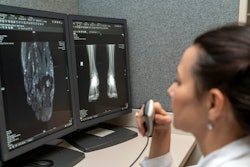Women in North America remain underrepresented in radiology subspecialties, leadership, and academia, according to an analysis published March 22 in Clinical Imaging.
A team led by Fatemeh Khounsarian, MD, from the University of British Columbia found that women comprise under half of radiologists in subspecialties (except breast imaging) and outlined strategies to address gender diversity in the field.
“We believe implementing the … strategies will contribute to a more diverse and representative discipline of radiology, ultimately leading to improved patient care and satisfaction,” Khounsarian and colleagues wrote.
While the overall number of female medical school graduates has increased in recent decades, the team noted that radiology residency programs in the U.S. and Canada have an overall lack of gender parity. Previous reports indicate that the proportion of women in radiology residency programs range between 26.7% and 32.6%.
Khounsarian et al outlined the state of women's representation within radiology in North America and explored potential solutions for addressing gender disparity. They analyzed 22 studies published between 2000 and 2022.
The analysis found that female representation ranged from 10.6% in interventional radiology to 45.1% in pediatric imaging. Breast imaging was the only subspecialty in which women outnumbered men, ranging between 69% and 79.1%.
Also, while women make up 34.7% of all academic radiologists, their representation decreases to 26.1% of full professors, the team reported.
In research, female radiology trainees participated less than their male counterparts (44.3% compared with 59.4%). This disparity was also reflected in published articles, with men again outnumbering women (40.2% compared with 27.9%). Additionally, 17% to 30% of women were first authors on studies while just 9% to 25% of last author positions were held by women.
Finally, the researchers reported that the COVID-19 pandemic disproportionately affected women early in their careers. With disruptions caused by the pandemic, the analysis found that the pandemic undermined many women’s potential for securing future leadership roles and promotions and intensified the existing gender disparity within radiology.
The team listed the following factors as being contributors to the gender gap: a lack of role models and mentors, limited preclinical exposure, patient contact and fear of AI, and a high rate of burnout.
Departments can take multiple steps to improve gender diversity. The researchers wrote that these include developing preclinical exposure and mentorship opportunities, supporting resident parents, and improving the culture of residency programs.
Examples of these include implementing family-oriented policies as well as equity, diversity, and inclusion (EDI) policies, providing a structured mentorship program that includes regular assessments and feedback delivery, offering expert opinions on AI in medical imaging, and implementing robust institutional policies addressing workplace equity and preventing harassment.
“Furthermore, fostering a positive and inclusive culture, creating a supportive work environment, and implementing robust institutional policies for equity will decrease the risk of burnout,” the authors wrote.
The full analysis can be found here.



















